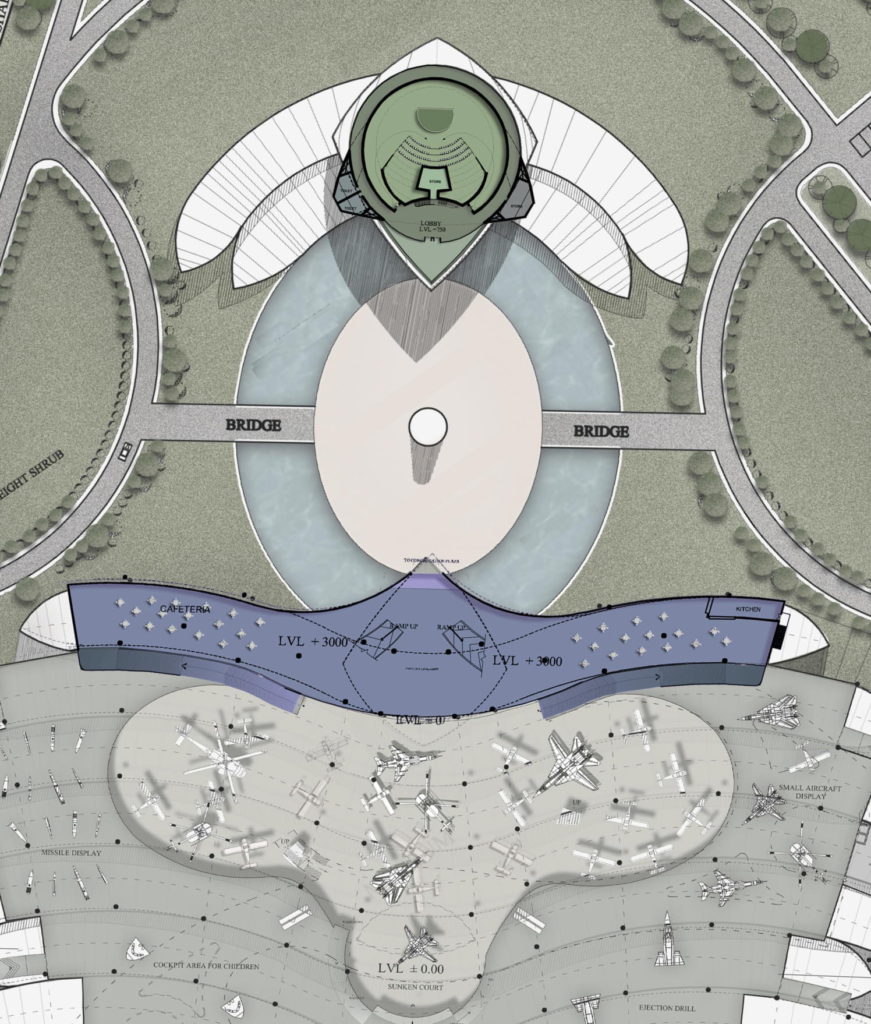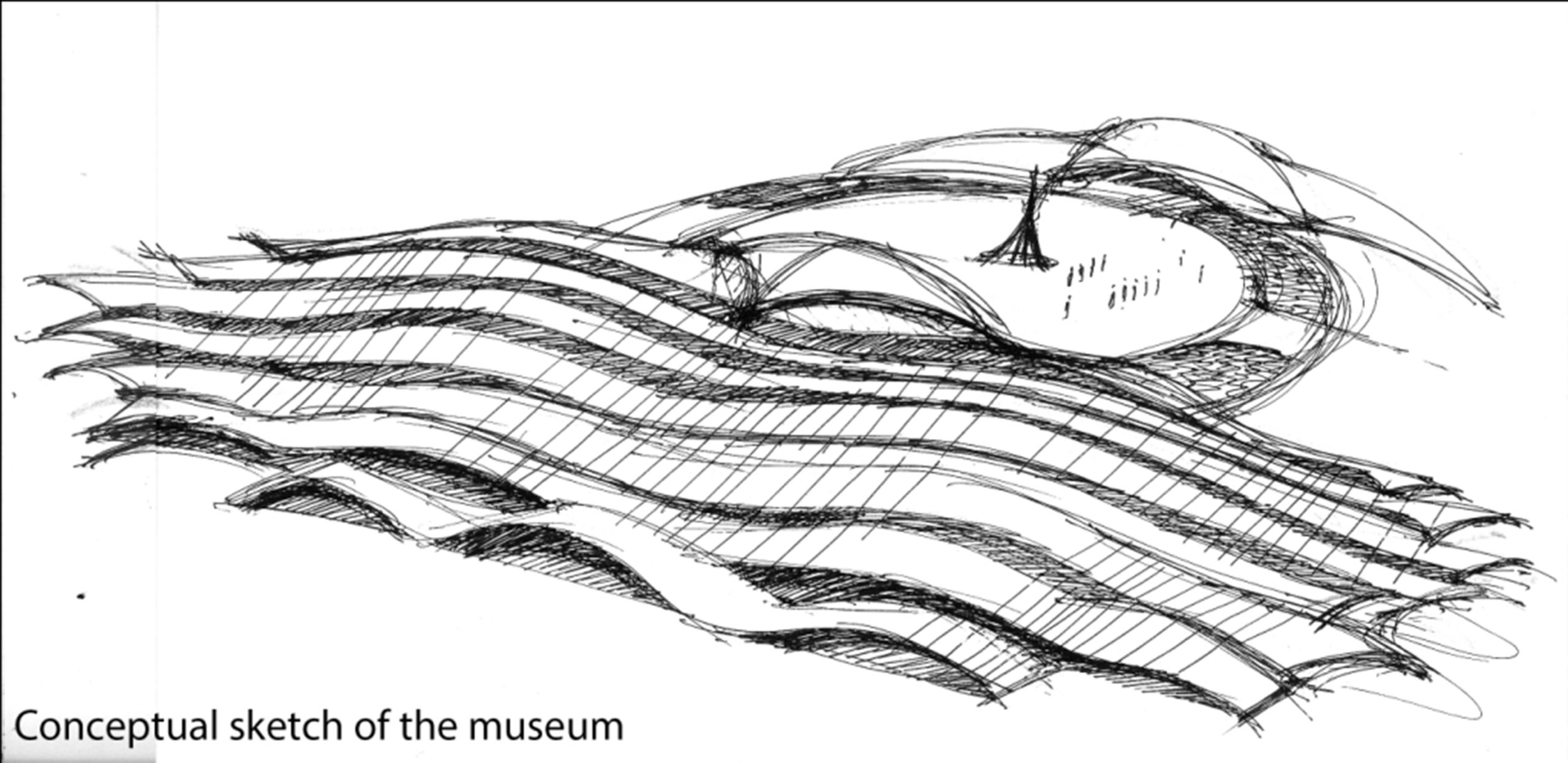The Air Force Museum exhibits a rich collection of memorabilia of Indian Military Aviation and displays the history of the Indian Air Force. Today, as it was earlier, the primary aim of the Indian Air Force Museum is to actively promote public interest in the Indian security domain and promote awareness, both from a historical and a contemporary point of view. The new Air Force Museum is envisioned to be the centre of attraction for a collection of various facilities aimed at promoting the knowledge of the Indian Air Force’s history and aviation.
Extracting from this aspect of function, the building design has been conceptualised to be an iconic symbol both visually and metaphorically. The logo of the Indian Air Force comprises the soaring eagle, which has evolved and been incorporated in the derivation of the built form. An eagle taking flight with spread out wings has been captured figuratively in the massing of the museum architecture. Since there is a height restriction of 20 meters, the horizontally spread layout is envisioned to serve best for the facility.
A contextual response to the site is maintained by deriving the main axis of the building from the angle created by the new (relocated) war memorial. The common plaza has been located such that it allows entry points to the War Memorial at various levels. The basic premise of this proposal is not restricted to the normal eye level of a visitor as the design unfolds in the hierarchy of functional volumes.
The design has been dealt in 4 dimensions to create a sense of visual magnificence for onlookers as well as from landing aircrafts which fly above the structure. The scheme of the design was to inculcate a sense of awe and wonder from various standpoints of display showcased inside the museum. At the same time emphasis was also laid on creating spaces and movement routes which improve visitor experience. The entire structure beholds a permanent exhibit value encompassing the flight of the force that spells command in true sense.

The Design layout
The building has been oriented in the NE-SW direction, which is ideal for the composite climate of Delhi. The museum has been designed keeping in mind one major axis, which passes through the main entrance leading to the War Memorial and then aligns itself to the IMAX auditorium.
The grand foyer at the entrance welcomes visitors into the museum and creates a visual link to the War Memorial at the end of the axis. The triple-height skylight beyond the reception forms the pinnacle of the experience at the end of the museum. The impressive vastness of the museum foyer is gated by the souvenir and the reception desk, which acts as an arched gateway to a grand open space that houses displays of aircraft. The central space is broken into many components and variable heights by the changing and modulating shapes of the above floors.
The upper floors are more like a ramp that covers a very small portion and takes one around the whole display space with changing perspectives. The ramps give a three-dimensional view of the exhibits on the ground floor, thus creating a breathtaking experience for the visitor. The varying levels and the organic shapes make the design a unique experience for a visitor, even during their subsequent visits. To enhance the visitor experience, the design has no unidirectional pattern but a sense of self-exploration and excitement.

The ramps and the design orientation guide the visitor to the war memorial in a very free, unrestricted and gradual way. The services and the ancillary facilities like the cafeteria are designed to be major points of attraction with high platform location and full glazing, which helps to achieve amazing views of the museum and generate a culminating and enriching experience.
The grand plaza of the War Memorial is a floating island surrounded by water and the focal point of the Museum. It can be made physically inaccessible while being visually connected to every visitor to the Museum. This memorial also forms a link between the Museum and the IMAX Dome, as the plaza can also be accessed from the outside during “Air Force Day” without going through the Museum.
The overall planning of the museum is flexible and can be altered as per requirement.
For a parking facility, the museum incorporates a basement parking of 400 cars, along with on-surface parking for VIP guests. A multi-level car Park is also proposed inside the campus.
The design emphasis has also been laid on the principles of energy conservation and sustainability, as the shell of the building is equipped with photo-voltaic panels, which generate solar energy utilising the southern exposure of the building envelope.
The landscaping of the complex has been designed using plants with water requirements corresponding to the local rainfall pattern, so that significantly less water will be needed for irrigation.


Project Details:
Name: Air Force Museum
Location: New Delhi
Designed by: Design Consortium
Typology: Cultural Architecture




